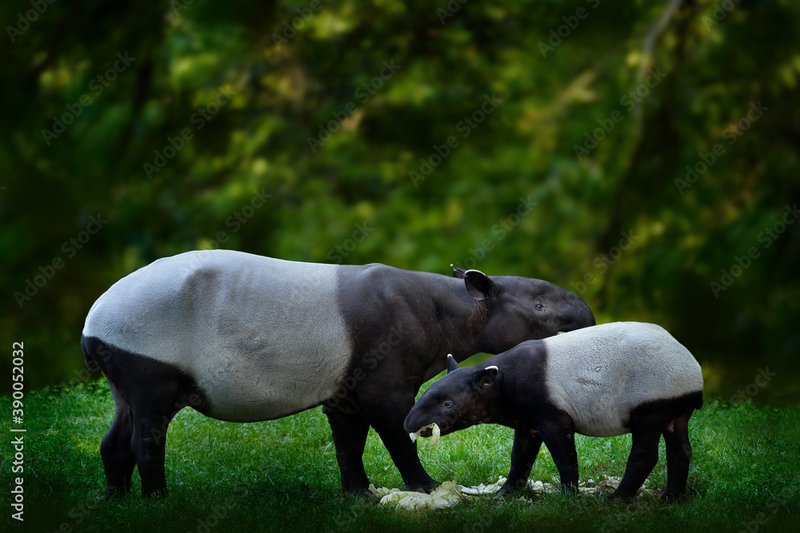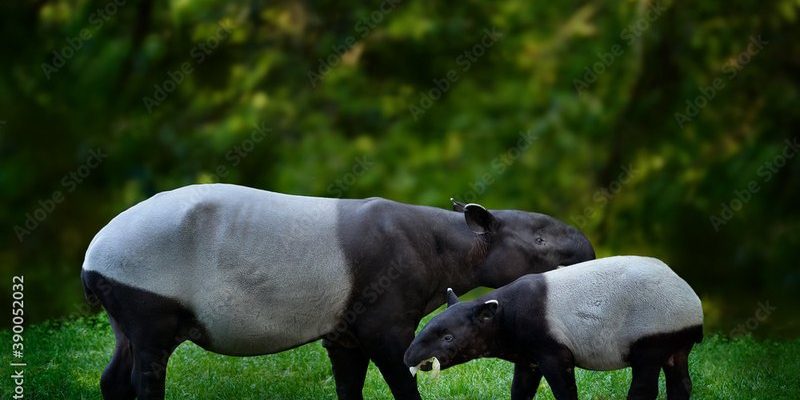
Malayan tapirs, native to Southeast Asia, live in dense forests and are quite shy creatures. They have a fascinating blend of characteristics, both similar to pigs and elephants, which makes them unique. Just like any parent, tapirs face challenges in raising their young, from finding enough food to keeping them safe from predators. Let’s dive into their world and uncover the ways these amazing animals nurture the next generation.
Understanding Tapir Family Dynamics
Malayan tapirs typically have a simple family structure, usually consisting of a mother and her calf. After a gestation period of about 13 months, the mother gives birth to a single calf. This is somewhat rare in the animal kingdom, where multiple births are common for many species. The bond between a mother and her calf is incredibly strong, as the mother invests a lot of time and energy in nurturing her young.
The mother tapir is quite protective. In the wild, she will keep her calf hidden for the first few weeks. This is a crucial time; the calf’s unique spotted coat helps it blend in with the forest floor. This camouflage is essential for escaping predators like large cats or even wild pigs. Can you imagine how important it is for a young tapir to stay hidden during those early, vulnerable days?
Feeding and Nutrition for Calves
As with all young animals, nutrition is a top priority for Malayan tapir calves. The mother primarily feeds on leaves, fruits, and bark, and she introduces her calf to this diet as soon as it’s ready. Initially, calves rely on their mother’s milk, which is rich in nutrients. Studies have shown that the milk can boost the calf’s growth significantly during those early months.
Here’s the thing: tapirs don’t just forage anywhere. They are selective eaters, choosing plants that are not only nutritious but also safe for their young. This careful attention to diet helps the calf develop the strength it needs to thrive. As they grow, calves start mimicking their mothers’ eating habits, becoming more adventurous and trying different types of vegetation. It’s like a culinary school in the wild!
Protective Behaviors of Mother Tapirs
Mother tapirs are exceptionally vigilant when it comes to their calves’ safety. They often stay close to their young, especially in the early weeks. If a threat appears, a mother tapir will communicate with her calf through various sounds and body language to signal danger. Think of it as an instinctive parenting technique that reflects the deep bond they share.
Additionally, mother tapirs will frequently change their resting spots to avoid detection. This means they’ll move to new areas with plenty of cover—like dense brush or tall grasses—to keep their calf hidden. In the wild, being discreet can make all the difference in survival. It’s an incredible strategy that highlights the adaptability of these gentle giants.
Learning and Development in Tapir Calves
As tapir calves grow, they engage in play that’s crucial for their development. This playful behavior helps them build strength, coordination, and social skills. You might observe a calf playfully nudging its mother or frolicking among the trees. This not only provides physical benefits but also strengthens their bond.
Interestingly, the play also teaches the calf vital survival skills. For instance, they might practice running or dodging, which are essential when evading predators. Imagine a young athlete training for a big game—this playful practice is the tapir’s version of preparing for life in the wild.
The Role of Habitat in Raising Young Tapirs
Tapirs thrive in thick, tropical forests and need a suitable habitat to raise their young successfully. These environments provide shelter and ample food sources. Deforestation and habitat loss are significant threats to tapirs, impacting their ability to nurture their young.
In areas where the forest is intact, tapirs have the space they need to roam and forage freely. This plays a critical role in the health of mothers and calves alike. Here’s a thought: without a rich ecosystem, the survival of these unique creatures is at risk. Efforts to preserve their habitats are essential for ensuring future generations of tapirs can flourish.
Challenges Faced By Young Tapirs
Despite their mother’s best efforts, young tapirs face numerous challenges. Predation is a constant threat, as many larger animals see tapir calves as easy prey. Additionally, habitat encroachment by humans can lead to increased stress and competition for food.
Malayan tapirs are solitary creatures, and their calves must learn to navigate this world on their own. This transition can be tough. As they grow older, they begin to venture further from their mothers, learning to find food and stay alert for danger. It’s a tough journey that shapes them into mature tapirs ready to live independently.
Conservation Efforts for Malayan Tapirs
Given the challenges young tapirs face, conservation efforts are more important than ever. Organizations around the world are working hard to protect tapir habitats, raise awareness, and promote sustainable practices. These initiatives not only help tapirs but also protect the rich biodiversity of tropical forests.
In places where tapirs thrive, eco-tourism can play a vital role in conservation. When people learn about these fascinating animals and contribute to their protection financially, it creates a win-win situation. It’s all about fostering a deep respect for wildlife and ensuring that future generations of tapirs can safely raise their young in the wild.
In conclusion, Malayan tapirs have a unique way of raising their young that is deeply intertwined with their environment. From the protective behaviors of mothers to the challenges faced by calves, the life of a tapir is full of fascinating dynamics. Understanding how they nurture their young not only highlights their remarkable qualities but also emphasizes the importance of conserving their habitats. Let’s work together to ensure these incredible creatures continue to thrive for years to come!

